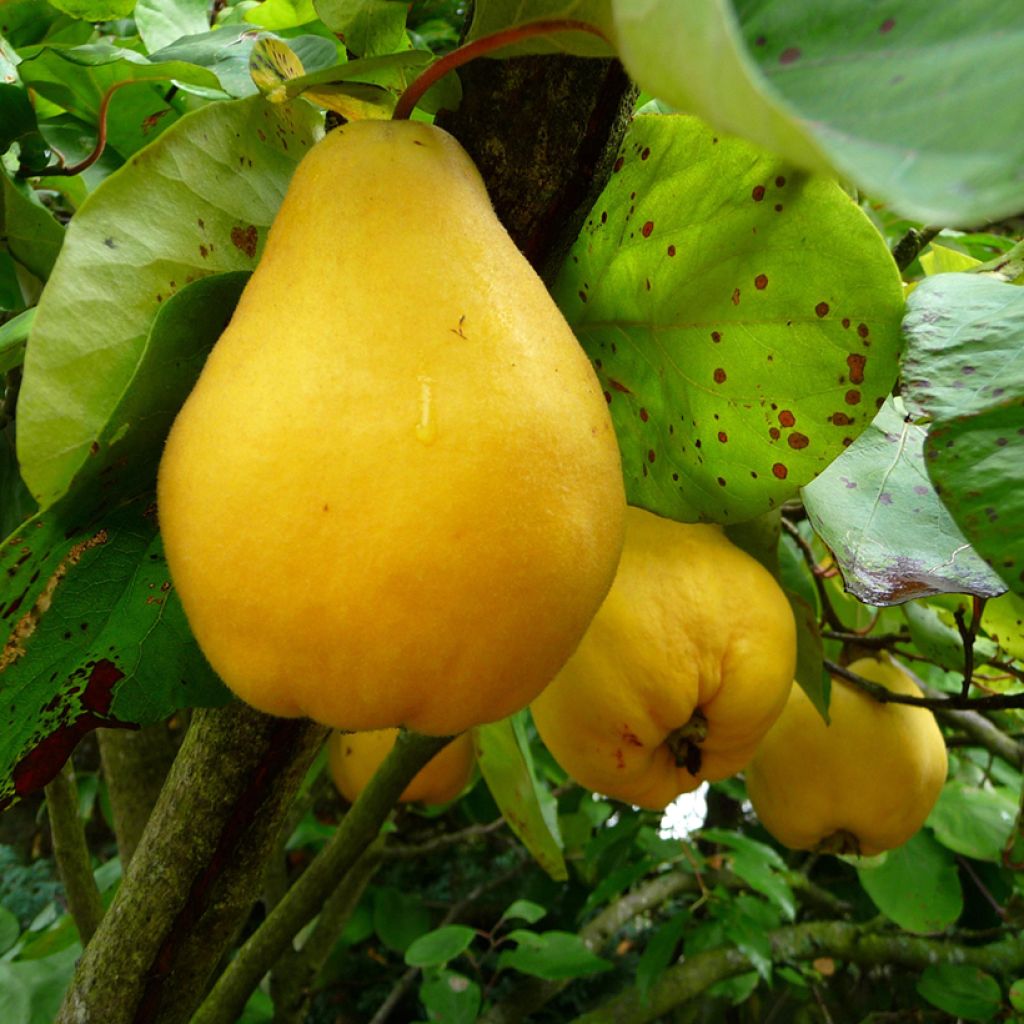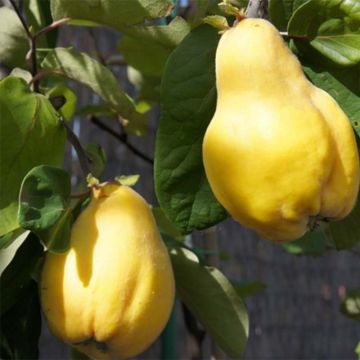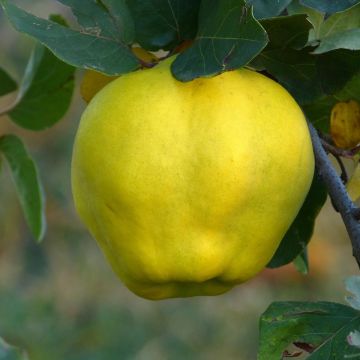

Cognassier Portugal Bio - Cydonia oblonga


Cognassier Portugal Bio - Cydonia oblonga


Cognassier Portugal Bio - Cydonia oblonga
Organic Quince Portugal - Cydonia oblonga
Cydonia oblonga Du Portugal
Quince
Why not try an alternative variety in stock?
View all →This plant carries a 6 months recovery warranty
More information
We guarantee the quality of our plants for a full growing cycle, and will replace at our expense any plant that fails to recover under normal climatic and planting conditions.
Oversize package: home delivery by special carrier from €6.90 per order..
Express home delivery from €8.90.

Description
The 'Portugal' Cydonia oblonga forms a small tree with a rounded habit, capable of both decorating the garden in spring with its flowering, providing shade, and producing excellent quality fruits in autumn. It produces a very large fruit, measuring 8 to 11 centimetres (3 to 4 inches) in diameter, weighing 700 to 900 grams, with a pear-shaped, ribbed, and slightly flattened base. Its thick skin is golden yellow in colour, with greenish hues on the shaded side, and is covered with a light fuzzy layer that disappears more or less when fully ripe. Its pale yellow flesh is firm, hard, fine, highly fragrant, moderately sweet, and has a slightly astringent taste when eaten, containing brown seeds. While astringent when raw, the flesh of the quince reveals its flavour and aromas when cooked, in countless sweet or savoury recipes. Hardy, vigorous, and resistant to diseases, the quince tree is easy to grow and requires almost no maintenance.
Plants from Organic Agriculture.
The quince tree, in Latin Cydonia oblonga, belongs to the Rosaceae family, just like the apple tree and the pear tree. This shrub is native to temperate regions of the Caucasus and Iran, from the Caspian Sea to the Black Sea: Iran, Armenia, Azerbaijan, Turkey, Caucasian Russia, Turkmenistan. It has become naturalized in France, mainly in the South.
The 'Portugal' variety was described in literature around 1760. This quince tree forms a small bushy tree, with a spreading habit and a rounded crown, reaching a height of 4 metres (13 feet), with a diameter of 2 to 3 metres (7 to 10 feet). It is recognizable by its twisted branches, with a greyish-brown bark covered with lenticels. Its deciduous foliage consists of oblong, alternate leaves measuring 6 to 10cm (2 to 4in) in length and 4 to 6cm (2in) in width, with wavy edges, almond green colour, and silver-white undersides, turning yellow-orange in autumn before falling. In April-May, the solitary flowers appear as pink buds, then open up into a wide corolla with 5 petals, measuring 3 to 5cm (1 to 2in) in diameter, white, tinged with pale pink. It is a remarkably decorative flowering in spring, fragrant and particularly attractive to bees and nectar-loving insects. This hardy tree can withstand temperatures as low as -25°C, but dislikes summer humidity, which can cause leaf and fruit spots, as well as entomosporiosis. Its late flowering is not easily affected by spring frosts. An self-fertile variety, not requiring other quince trees nearby for pollination, although the presence of another quince tree will improve fertility. The fruit harvest begins around late September and continues until November, as they ripen.
Quinces are harvested by hand before they fall from the tree, to avoid damage. The fruits can be consumed right after harvest. Their hard and astringent flesh makes them unpleasant to eat raw, so it is essential to cook them. The flesh oxidizes quickly once the skin is removed, but without altering the taste. Quinces are not very sweet, but they are particularly rich in fibre, especially pectin, a naturally gelling carbohydrate. They are also rich in antioxidants, vitamin C, and minerals (copper and potassium). This natural pectin richness facilitates the transformation of fruits into jams, quince pastes, or jellies. When combined with apples, quinces are delicious in compotes. They also add their flavours to sweet recipes (crumbles, tarts, cakes, etc.) as well as accompanying savoury dishes with poultry (guinea fowl, duck, etc.), pork, game, or fish (salmon, sea bream, etc.), or in harmony with a cheese platter. Since quinces affect the ripening of other pome fruits, it is advisable not to store them together.
Easy to cultivate and not demanding, the quince tree prefers a sunny exposure, ordinary soil, rich, deep, and not overly calcareous. The 'Portugal' Cydonia oblonga offers a abundant harvest and quick fruiting, around 3 to 4 years, with optimal fruit production after 5 to 6 years. It is suitable for cultivation in all regions, but requires warmth in autumn for good fruit ripening. With a wide range of quince tree varieties, it is easy to find the one that best suits your desires.
Report an error about the product description
Plant habit
Fruit
Flowering
Foliage
Botanical data
Cydonia
oblonga
Du Portugal
Rosaceae
Quince
Cultivar or hybrid
Other Quince trees
Planting and care
Easy to grow in many regions (it still loves the sun and heat), the Quince tree can be cultivated in all types of soil, whether neutral, acidic, or even slightly limestone. Planting the Quince tree is done in autumn or winter, when there is no frost. It appreciates sunny or semi-shaded exposures and sheltered locations. The Quince tree thrives in fertile and light soils. If you plant multiple plants, space them 4 to 6 metres (13 to 20 feet) apart for a fruitful harvest.
Prepare the soil by removing rocks and unwanted weeds. Dig a hole about 50 to 60cm (20 to 24in) in all directions. Make sure to separate the subsoil from the topsoil. Mix crushed horn or well-rotted compost or potting soil with the subsoil and pour this mixture into the planting hole. Install a stake. Place the root ball, cover with the topsoil, and tamp down well. Water generously (about 10 L). Attach the stake to the plant, crossing the tie in the shape of an 8, without touching the trunk.
Water regularly, especially during the first years of planting and in case of high temperatures. Mulch around the soil to limit watering and the growth of adventive plants.
The Quince tree can be susceptible to moniliosis (a fungus causing fruit rot) and entomosporiosis (a fungus causing brown spots on the leaves). Remove affected fruits. Spray a horsetail decoction during flowering and apply copper-based treatments such as Bordeaux mixture when the leaves fall and during bud break. In case of aphid infestation, spray water with black soap.
Planting period
Intended location
Care
This item has not been reviewed yet - be the first to leave a review about it.
Haven't found what you were looking for?
Hardiness is the lowest winter temperature a plant can endure without suffering serious damage or even dying. However, hardiness is affected by location (a sheltered area, such as a patio), protection (winter cover) and soil type (hardiness is improved by well-drained soil).

Photo Sharing Terms & Conditions
In order to encourage gardeners to interact and share their experiences, Promesse de fleurs offers various media enabling content to be uploaded onto its Site - in particular via the ‘Photo sharing’ module.
The User agrees to refrain from:
- Posting any content that is illegal, prejudicial, insulting, racist, inciteful to hatred, revisionist, contrary to public decency, that infringes on privacy or on the privacy rights of third parties, in particular the publicity rights of persons and goods, intellectual property rights, or the right to privacy.
- Submitting content on behalf of a third party;
- Impersonate the identity of a third party and/or publish any personal information about a third party;
In general, the User undertakes to refrain from any unethical behaviour.
All Content (in particular text, comments, files, images, photos, videos, creative works, etc.), which may be subject to property or intellectual property rights, image or other private rights, shall remain the property of the User, subject to the limited rights granted by the terms of the licence granted by Promesse de fleurs as stated below. Users are at liberty to publish or not to publish such Content on the Site, notably via the ‘Photo Sharing’ facility, and accept that this Content shall be made public and freely accessible, notably on the Internet.
Users further acknowledge, undertake to have ,and guarantee that they hold all necessary rights and permissions to publish such material on the Site, in particular with regard to the legislation in force pertaining to any privacy, property, intellectual property, image, or contractual rights, or rights of any other nature. By publishing such Content on the Site, Users acknowledge accepting full liability as publishers of the Content within the meaning of the law, and grant Promesse de fleurs, free of charge, an inclusive, worldwide licence for the said Content for the entire duration of its publication, including all reproduction, representation, up/downloading, displaying, performing, transmission, and storage rights.
Users also grant permission for their name to be linked to the Content and accept that this link may not always be made available.
By engaging in posting material, Users consent to their Content becoming automatically accessible on the Internet, in particular on other sites and/or blogs and/or web pages of the Promesse de fleurs site, including in particular social pages and the Promesse de fleurs catalogue.
Users may secure the removal of entrusted content free of charge by issuing a simple request via our contact form.
The flowering period indicated on our website applies to countries and regions located in USDA zone 8 (France, the United Kingdom, Ireland, the Netherlands, etc.)
It will vary according to where you live:
- In zones 9 to 10 (Italy, Spain, Greece, etc.), flowering will occur about 2 to 4 weeks earlier.
- In zones 6 to 7 (Germany, Poland, Slovenia, and lower mountainous regions), flowering will be delayed by 2 to 3 weeks.
- In zone 5 (Central Europe, Scandinavia), blooming will be delayed by 3 to 5 weeks.
In temperate climates, pruning of spring-flowering shrubs (forsythia, spireas, etc.) should be done just after flowering.
Pruning of summer-flowering shrubs (Indian Lilac, Perovskia, etc.) can be done in winter or spring.
In cold regions as well as with frost-sensitive plants, avoid pruning too early when severe frosts may still occur.
The planting period indicated on our website applies to countries and regions located in USDA zone 8 (France, United Kingdom, Ireland, Netherlands).
It will vary according to where you live:
- In Mediterranean zones (Marseille, Madrid, Milan, etc.), autumn and winter are the best planting periods.
- In continental zones (Strasbourg, Munich, Vienna, etc.), delay planting by 2 to 3 weeks in spring and bring it forward by 2 to 4 weeks in autumn.
- In mountainous regions (the Alps, Pyrenees, Carpathians, etc.), it is best to plant in late spring (May-June) or late summer (August-September).
The harvesting period indicated on our website applies to countries and regions in USDA zone 8 (France, England, Ireland, the Netherlands).
In colder areas (Scandinavia, Poland, Austria...) fruit and vegetable harvests are likely to be delayed by 3-4 weeks.
In warmer areas (Italy, Spain, Greece, etc.), harvesting will probably take place earlier, depending on weather conditions.
The sowing periods indicated on our website apply to countries and regions within USDA Zone 8 (France, UK, Ireland, Netherlands).
In colder areas (Scandinavia, Poland, Austria...), delay any outdoor sowing by 3-4 weeks, or sow under glass.
In warmer climes (Italy, Spain, Greece, etc.), bring outdoor sowing forward by a few weeks.











































